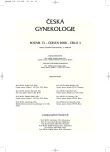Survival in Children with Birth Defects during First Year of their Life
Authors:
V. Gregor 1,2; A. Šípek 1,3; J. Horáček 1; A. Šípek jr. 4; P. Langhammer 5
Authors‘ workplace:
Oddělení lékařské genetiky, Fakultní Thomayerova nemocnice, Praha, ředitel MUDr. K. Filip, CSc., MBA
1; Institut postgraduálního vzdělávání ve zdravotnictví, Praha, Katedra lékařské genetiky, ředitel MUDr. Z. Hadra
2; Ústav pro péči o matku a dítě, Praha-Podolí, ředitel doc. MUDr. J. Feyereisl, CSc.
3; 1. lékařská fakulta Univerzity Karlovy, děkan prof. MUDr. T. Zima, DrSc., MBA
4; Ústav zdravotnických informací a statistiky České republiky, ředitelka Mgr. V. Mazánková
5
Published in:
Ceska Gynekol 2008; 73(3): 163-169
Overview
Objective:
To analyze infant mortality in children with selected types of birth defects during a first year of their life.
Design:
A retrospective study with an analysis of prenatal and postnatal occurence of birth defects in the Czech Republic during 1994 – 2006.
Setting:
Department of Medical Genetics, Thomayer’s University Hospital, Prague.
Chair of Medical Genetics, Postgraduate Medical Institute, Prague.
Methods:
Data were collected from national registers (Institute of Health Information and Statistics) and particular departments of medical genetics. A study of frequency of 14 selected birth defects was performed along with an analysis of survival and mortality in children with birth defects during a first year of their life.
Results:
In 1994 – 2006, totally 1 132 567 children were born in the Czech Republic, out of which more than 42 000 with a birth defect. A mean incidence was 339 per 10 000 live births with a maximum of 414.58 per 10 000 in 2003. In correctible defects, first year survival was lowest in congenital hydrocephalus (72%) and neural tube defects (anencephaly excluded) (71%). In congenital defects of gastro-intestinal tract and in abdominal wall defects survival was between 82–91%.
Conclusion:
Birth defects present an important contribution to an infant mortality and morbidity in the first year of life. In a comparison of 1980 – 1993 and 1994 – 2006 periods, a significant increase of prenatal diagnostics efficiency was recorded.
Key words:
birth defect, perinatal mortality, neonatal mortality, anencephaly, spina bifida, encephalocele, neural tube defects, congenital hydrocephalus, omfalocele, gastroschisis, abdominal wall defects, oesophageal defects, anorectal malformations, diaphragmatic hernia, renal agenesis/hypoplasia, cystic kidney, Down syndrome, Czech Republic.
Sources
1. al-Dabbous, IA., Owa, JA., Nasserallah, ZA., al-Qurash, IS. Perinatal morbidity and mortality in offspring of diabetic mothers in Qatif, Saudi Arabia. Eur J Obstet Gynecol Reprod Biol, 1996, 65, 2, p. 165-169.
2. Barisic, I., Clementi, M., Hausler, M., et al.; Euroscan Study Group. Evaluation of prenatal ultrasound diagnosis of fetal abdominal wall defects by 19 European registries. Ultrasound Obstet Gynecol, 2001,18, 4, p. 309-316.
3. Botto, LD., Mulinare, J., Erickson, JD. Occurrence of congenital heart defects in relation to maternal mulitivitamin use. Am J Epidemiol, 2000, 151, 9, p. 878-884.
4. EUROCAT Working Group. Prevalence of neural tube defects in 20 regions of Europe and the impact of prenatal diagnosis, 1980-1986. , 1991, 45, 1, p. 52-58.
5. EUROCAT Working Group. Prevalence of neural tube defects in 16 regions of Europe, 1980-1983. 1987, 16, 2, p. 246-251.
6. EUROCAT Working Group. Prevalence of neural tube defects in 20 regions of Europe and the impact of prenatal diagnosis, 1980-1986. , 1991, 45, 1, p. 52-58.
7. Forrester, MB., Merz, RD. Prenatal diagnosis and elective termination of Down syndrome in a France. Eur J Obstet Gynecol Reprod Biol, 2006, 125, 2, p. 202-5. Epub 2005 Aug 15.
8. Garne, E., Loane, M., Dolk, H., et al. Prenatal diagnosis of severe structural congenital malformations in Europe. Ultrasound Obstet Gynecol, 2005, 25, 1, p. 6-11..
9. Gregor, V., Šípek, A., Mašátová, D. Podíl prenatální diagnostiky na snižování výskytu vrozených vad v ČR. Čes Gynek, 2003, 68, 6, s. 23-28.
10. Šípek, A., Gregor, V., Mašátová, D. Výskyt vrozených vad a úspěšnost prenatální diagnostiky v ČR v roce 2000. Čes-slov Pediat, 2002, 57, s.243-251.
11. Šípek, A., Gregor, V., Horáček, J., Mašátová, D. Analýza vrozených vad podílejících se na perinatální úmrtnosti v ČR. Čes Gynek, 2003, 68, 6, s. 18-22.
12. Šípek, A., Dzúrová, D., Gregor, V. Incidence a přežívání dětí v prvním roce života s vybranými typy vrozených vad v ČR v období 1994 – 1998. 1. část. Čes-slov Pediat, 2002, 57, 6, s. 320-328.
13. Šípek, A., Dzúrová, D., Gregor, V. Incidence a přežívání dětí v prvním roce života s vybranými typy vrozených vad v ČR v období 1994 – 1998. 2. část. Čes-slov Pediat, 2003, 58, 3, s.153-161.
14. Šípek, A., Gregor, V. Horáček, J., et al. Výskyt a přežívání dětí s vybranými typy vrozených vad v České republice v období 1994 - 2001. 1. část. Čes Gynek, 2004, 69, 1, s. 57-63.
15. Šípek, A., Gregor, V. Horáček, J., et al. Výskyt a přežívání dětí s vybranými typy vrozených vad v České republice v období 1994 - 2001. 2. část. Čes. Gynek, 2004, 69, 1, s. 64-70.
16. Šípek, A., Gregor, V. Horáček, J., Mašátová, D. Přežívání dětí narozených s vybranými typy vrozených vad v České republice. Čes Gynek, 2004, 69, Suppl. 47-52.
17. Šípek, A., Gregor, V., Horáček, J. Vrozené vady v České republice v období 1994-2005 – perinatologická data. Čes Gynek, 2007, 72, 2, s. 103-109.
18. Šípek, A., Gregor, V., Horáček, J. Vrozené vady v České republice v období 1961 až 2005 – průměrné incidence. Čes Gynek, 2007, 72, 3, s. 185-191.
Labels
Paediatric gynaecology Gynaecology and obstetrics Reproduction medicineArticle was published in
Czech Gynaecology

2008 Issue 3
Most read in this issue
- Preterm Premature Rupture of Membranes and Ureaplasma urealyticum
- Postpartal Atraumatic Sacral Fracture. A Case Report and Biomechanical Comments
- Sclerosing Stromal Tumor – a Rare Benign Ovarian Neoplasm
- Etiopathogenesis of Uterine Fibroid: Current Knowledge
